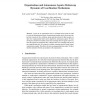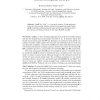1126 search results - page 14 / 226 » Modularity and the Rule of Adaptation |
VL
1996
IEEE
14 years 18 days ago
1996
IEEE
An often-mentioned advantage of rule-based programming languages is that a program can be extended simply by adding a few more rules. In practice however, the rules tend to be dep...
ATAL
2008
Springer
13 years 9 months ago
2008
Springer
Agents in an organization need to coordinate their actions in order to reach the organizational goals. Organizational models specify the desired behaviour in terms of roles, relati...
CADE
1998
Springer
14 years 21 days ago
1998
Springer
Abstract. leanK is a "lean", i.e., extremely compact, Prolog implementation of a free variable tableau calculus for propositional modal logics. leanK 2.0 includes additio...
FDL
2004
IEEE
14 years 5 days ago
2004
IEEE
In this paper, we are concerned with studying the semantic of the B modularity. We reuse the Harper-Lillibridge-Leroy (HLL) module system. This system implements an SML like module...
IROS
2009
IEEE
14 years 3 months ago
2009
IEEE
— In nature, animal groups achieve robustness and scalability with each individual executes a simple and adaptive strategy. Inspired by this phenomenon, we propose a decentralize...


